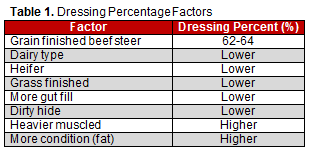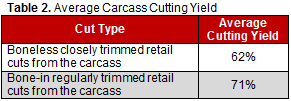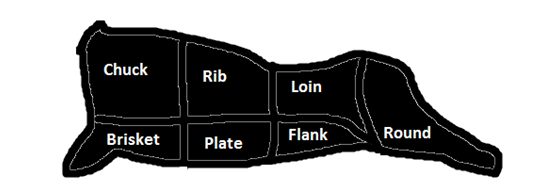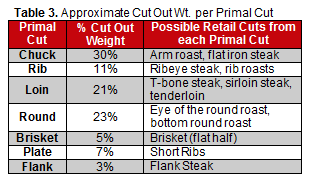How Much Fat in a Pound of Beef
- A carcass is comprised of lean (meat), fat (adipose) and bone
- The head, hide, feet, blood and viscera are not components of a carcass
- Carcass cutting yield is just one factor that influences the amount of take-home product
- Beef purchased from locker plants are typically sold as halves, quarters or split sides
Dressing Percentage
To better understand the amount of meat you may expect from a finished beef animal, the first step is understanding the difference in live weight compared to carcass weight. When a beef animal is harvested certain components of the animal such as the head, hide, feet, blood, and viscera (internal organs) are removed. The remaining lean (meat), fat (adipose), and bone, makes up the carcass hanging weight. Calculating dressing percentage will help determine how the carcass may yield from the live animal and will be influenced by many factors such as muscle score, genetics, amount of fill, and more (Table 1).
Dressing Percentage = (Carcass weight/Live weight)*100

Carcass Fabrication
The next thing to consider is more weight will be lost when a carcass is fabricated, or broken down into smaller (i.e. retail) cuts. The percentage of carcass weight remaining as "take-home" product is called the carcass cutting yield.
Important Note: Water Loss
Hot carcass weight is the weight of a carcass prior to chilling. A beef carcass consists of 70 to 75 percent water. As the carcass chills and ages, water will be lost through evaporation. In just the first 24 hours a carcass can lose up to 2 to 5 percent of its initial weight.
Chilled Carcass Weight * Carcass Cutting Yield = pounds of "take-home meat"
Carcass cutting yield is variable and depends on the carcass's fat thickness (leaner carcasses have a more desirable and higher carcass cutting yield), muscling (the greater the muscling the higher the yield), and the amount of bone-in versus boneless retail cuts. Deboned, or boneless, retail cuts will lower the carcass cutting yield (Table 2).

Requesting closely trimmed and boneless steaks and roasts and/or trimmed, lean (90:10, lean:fat) ground beef will result in less pounds of take-home product. This may be advantageous depending on freezer space availability and eating preferences. It is important to understand that the amount of edible meat will be the same regardless if the retail cuts are boneless or bone-in.
Choosing to bring home organ meats such as liver, heart, and tongue will also influence the pounds of meat product you take-home.
Understanding Primal vs Retail Cuts
The first cuts made to a whole carcass are to divide the carcass into primal cuts (Figure 1). Each primal cut will be further fabricated into a variety of bone-in or boneless retail cuts. For example, the loin may be broken down into bone-in rib, T-bone, porterhouse, and sirloin steaks with boneless alternatives while the chuck may be broken down into bone-in or boneless chuck and arm steaks and/or roasts, and/or stew meat (Table 3). Ground beef comes from trimmings of multiple primal cuts especially the chuck and round due to their muscle structure and lack of tenderness. Ground beef can also be further processed into specialty meats such as summer sausage and snack sticks.

Figure 1. Beef Primal Cuts

Purchasing Locally Raised Beef
Many farmers and locker plants sell beef by halves, quarters, or split sides. Beef carcasses are split down the spine into two halves for easier handling, better chilling, storage and aging processes – this results in what is referred to as 'a half of beef'. When determining roughly how much meat you should expect from a half of beef, take the pounds of meat previously calculated for the entire carcass and divide by two.
When buying a quarter of beef you are either buying an entire forequarter or a hindquarter from one of the half sides. If you purchase a forequarter you will receive cuts from the chuck, rib, brisket, and plate. If you purchase a hindquarter you will receive retail cuts from the loin, round, and flank. It is important to understand that if you purchase a hindquarter you will not receive cuts from the chuck, rib, or brisket such as arm roasts, chuck roasts, ribeye steaks, etc.
Some farmers and locker plants will sell a split side meaning you are purchasing a quarter of the meat with an assortment of cuts from an entire side. This option is desirable if you want certain cuts from both the fore- and hindquarters.
Example Meat Yield Calculations
- Live weight x typical dressing percent = hot carcass weight 1200 lb x 62% = 744 lb
- Hot carcass weight x (100 – shrink) = chilled carcass weight 744 x (100% – 3.5%) = 718 lb
- Chilled carcass weight x carcass cutting yield percent = pounds of take home product 718 lb x 67% = 481 lb
For More Information
Contact your local Extension Educator; Wisconsin Department of Agriculture, Trade and Consumer Protection; or Wisconsin Beef Council.
References
Beef Cuts: Primal & Subprimal Weights and Yields. 2013. Beef Checkoff. Print. Access Date: June 10, 2020.
Aberle, Elton David. Principles of Meat Science. 4th ed., Kendall/Hunt. 2001.
Coyne, J.M.; R.D. Evans; and D.P. Berry. 2019. Dressing percentage and the differential between live weight and carcass weight in cattle are influenced by both genetic and non-genetic factors. J. Anim. Sci. 97(4):1501-1512.
Holland, Rob; Dwight Loveday; and Kevin Ferguson. How much meat to expect from a beef carcass. University of Tennessee Extension. Print. Access Date: June 10, 2020.
Thiboumery, Arion; Kristine Jepsen; and Kristi Hetland. 2013. Beef and Pork Whole Animal Buying Guide. Iowa State University Extension and Outreach. Print. Access Date: June 10, 2020.
Wulf, Duane M. "Did the Locker Plant Steal Some of My Meat?" South Dakota State University. Print. Access Date: June 10, 2020.
Download Article
Source: https://livestock.extension.wisc.edu/articles/how-much-meat-should-a-beef-animal-yield/
0 Response to "How Much Fat in a Pound of Beef"
Post a Comment